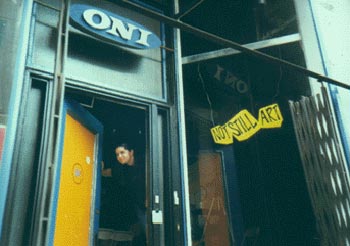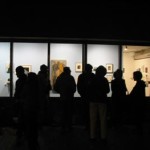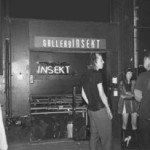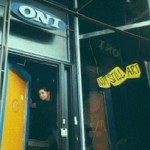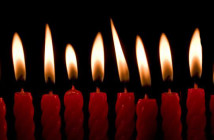Walking down Washington Street to get lunch at New Saigon Sandwich, I looked up at the darkened windows above the corner at Beach Street. My heart gave a little leap, then sank a bit, and I thought "God, I miss Oni Gallery."
It seems that so many alternative spaces only exist in nostalgia. I remember the first exhibition I saw after returning to Boston in 2001, climbing up those stairs to the crowded chaos of Oni. The work was engaging and memorable (a piece by Dave Webber still stands out) and the whole experience made me happy that I had chosen Boston. Later, as I put together exhibitions with the Oni folks, I was impressed by their willingness to help artists, to make things happen, and to present work that was not remotely commercially viable.
As these thoughts passed through my head, though, I also felt pangs of nostalgia for others spaces, too. There was the serious intensity of the elevator trip up to Mobius, followed by a performance by Marilyn Arsem or Cave Dogs. There was the deafening beauty of Devil Music at The Berwick. I was suddenly heartsick for the days of 84 Kingston, for the Degenerate Show at Gallery Insekt, for The White Elephant Gallery and Bad Grrls Studios...
While I ate my sandwich, I pondered all of these places, most of them gone now, and what it meant for me as an artist to work with them. I thought about what has replaced them, who is taking the place of these spaces for young artists graduating this year, entering our arts scene and making work in the current Boston moment. I thought about how I would enter the scene now, were I 21 and looking for a home, and what the options are today.
In a previous article on Big RED, I wrote about the various layers of the Boston arts system, and how the different aspects interconnect to put the right artist and the right work in the proper context. One of these layers was the non-profit sector, galleries and venues that show work without a need to sell. These spaces function as incubators, and it is my firm belief that no art scene functions without a working and active incubator community.
To begin with, artists do not enter the arts community fully formed. While it is a great thing to have powerful ideas and make strong work, it is a whole other beast to put work on a wall and let the world talk about it. From the big questions ("What about frames?" or "Will the floor support the weight of the work?") to the minutiae ("What goes on a gallery tag?" or "What time do I show up?"), artists need to present their work a few times before they have a sense of what it means to show in a gallery. Writing press releases, calling friends, finding crucial connections, and making sure everything is in order before the opening are all skills that are learned by experience only. Once the show is up, dealing with potential buyers, talking to the press, and absorbing bad reviews are all part of the skills one needs to develop before the practice of being an artist and the business of being an artist start to coalesce.
This is where incubator spaces become important. They host exhibitions by young artists, fresh to the scene. More often than not these artists have little experience with shows, and while their voice may be strong and their work may be awesome, they are not particulary skilled at the detail management of the art business. Incubator spaces lay out a soft cushion for the artists to fall on. They become the voice and the reputation that these young artists can retreat behind, in the name of the 'avant garde' or 'alternative exhibitions' or any other number of neologisms that try to hide the fact that 'new' often means 'inexperienced.'
Being inexperienced is not a bad thing. It is a state that everyone must pass through, for each and every new skill they want to master in life. We have all been inexperienced at walking, sex, golf, cooking, reading, and many other things at one time. For many others, we are still novices. An inexperienced artist is not a bad artist or a worthless artists; on the contrary, they are an artist who needs an opportunity to learn the skills required to be a professional artist.
Incubator spaces provide the bridge for novice artists, often art students graduating into an unsure future, to cross into professionalism. They offer opportunities no other space can afford to provide: the opportunity to fail. Commercial galleries cannot fail too often, or they will go out of business. Drew Katz, of Gallery Katz, once commented: "As much as I like the work, I’m not going to be in business very long unless some of the work moves."
Academic galleries and museums steer clear of the new artists for different reasons, mostly due to their need to present established work as viable against an existing dogma. New artists may find their way in through indirect channels, be they student shows or competitions or promotional sales, but rarely through the direct curatorial process. This is not to say that the value of skills gained in the exhibition is lost on the novice artist, only that the experience is incidental to larger agendas that care little about the artist.
Incubator spaces are the most important aspect of any growing and prosperous art scene. They are where young artists come to maturity, and established artists go to try works that are risky. These spaces ultimately provide the commercially viable and academically relevant artists that make a community worthwhile. Often destroyed by progress and forgotten over time, it is important to remember that there is no art scene without them.
God, I miss Oni Gallery. God, I miss 1000 others like them. My career as a young artist, and the careers of many of my friends, are built upon the generosity of these spaces. The future of our scene is built on the backs of The Berwicks and Axioms and Zeitgeists and Mobiuses and Onis of Boston. They may come and go, but while they are around we must encourage them, support them, and never forget that their white walls are our past, and our future.
Oni Gallery image found here.
Gallery Insekt image courtesy of their website.
Green Street Gallery image by Matthew Nash.

